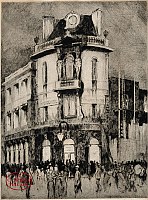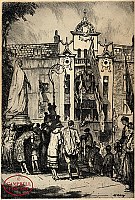Alexander J. Heaney (1876 - 1936) - Bristol life from 1912 to 1930.
Exhibition
page 1
Alexander J. Heaney was one of a group of highly talented etchers who emerged from Bristol during the first decades of the twentieth century, at the height of the British Etching Revival. His earliest etchings, dating from 1912, all depict views in and around the city of Bristol, and its was this area which was to remain the focus of Heaney’s attention despite his work becoming increasingly figurative in nature as time progressed. The original printed works which Alexander Heaney produced over the following twenty years can now be seen to represent one of the most fascinating contemporary records of life in Bristol prior to the Second World War.
Alexander Heaney was elected as an artist member of the private arts club known as the Bristol Savages in 1915. At that time the Bristol Savages boasted the outstanding etcher and engraver, Stanley Anderson amongst their ranks and a number of Heaney’s plates reflect the direct influence of this connection. Over the following years, the club attracted some of the finest etchers in the country to join its membership, including the likes of Harry Banks, Willis Paige and others. Alexander Heaney was an extremely active member of the club, contributing regularly to the Club’s publications and becoming President in 1923. The Savages' historian records him as: 'Never a robust type, he was tall, lean, clean-shaven and with a thick crop of black hair. The sad expression he wore on his face was due, possibly, to his failing health... he was of a shy and retiring nature'. He had to retire from work in the early 1930’s because of ill-health; however, he continued to exhibit his etchings with the Savages until the year before his death in 1936.
Little is known of Alexander Heaney’s origins. He came to Bristol as a Customs & Excise officer and although he bore an Irish name and spoke with a slight brogue his place of birth remains unknown. He studied art at the Royal West of England Academy between the years 1910 and 1913, but he did not contribute to their annual exhibitions. It was as a member of the Bristol Savages Club that his talents as an original printmaker became apparent; however, Heaney only occasionally exhibited at the Royal Academy of Arts in London and just once in Chicago. It appears he had no appetite for fame, preferring to remain the true, enthusiastic amateur who asked for nothing more than enjoyment from his pursuits as an artist and the companionship of his society.
Alexander Heaney’s enduring legacy will be derived from his vigorous etchings and drypoints of Bristol life between 1912 and 1930. Aside from one Shakespearean etching, a single biblical subject, and some historical costume-pieces which he drew for the Bristol Savages Club publication, Grouse, Alexander Heaney’s works had been thought not to be illustrative; however, the discovery of numerous pen and ink illustrations in the collection of the artist’s family has shed new light on his activities as an artist. How many of these illustrative works were published remains unknown.
Heaney experimented extensively with different printmaking techniques, as can be seen by comparing his heavily etched Cabot Café with the carefully grounded atmospheric tones which he created in his view of A Tobacco Warehouse seen from Bristol Docks. He sometimes chose drypoint over etching, probably for the rich dark tones which the drypoint medium can create. The discovery of many pencil and charcoal sketches for both his etchings and his drypoints, together with finished squared up ink drawings for his plates, confirms that his printed works were carefully planned creations, often taking many months in preparation. Although listed as an ‘Etcher and Engraver’ at his Fishponds address in Bristol by Fine Prints of the Year up to the end of the 1920’s, no published edition of Heaney’s etchings or drypoints is declared in any issue. No impressions of Heaney’s works are numbered and it appears that none was ever published in any formal edition. His etchings and drypoints are now universally rare.
Whilst recognised nearly 25 years ago in Sheena Stoddard’s City Impressions, Bristol Etchers 1910-1935 (City of Bristol Museum & Art Gallery, 1990), the true significance of the Bristol etchers prior to the Second World War is only now becoming apparent. Around thirty etchers and original printmakers of note emerged from Bristol during this period, more than the total output from Scotland during the Etching Revival and second only to London as a single location. As the importance of this loosely associated body of printmakers becomes appreciated in the way that the Norwich School is now recognised, figures such as Alexander J. Heaney will be regarded as having made a significant contribution to the wonderful variety of original printmaking in England.
Alexander Heaney was elected as an artist member of the private arts club known as the Bristol Savages in 1915. At that time the Bristol Savages boasted the outstanding etcher and engraver, Stanley Anderson amongst their ranks and a number of Heaney’s plates reflect the direct influence of this connection. Over the following years, the club attracted some of the finest etchers in the country to join its membership, including the likes of Harry Banks, Willis Paige and others. Alexander Heaney was an extremely active member of the club, contributing regularly to the Club’s publications and becoming President in 1923. The Savages' historian records him as: 'Never a robust type, he was tall, lean, clean-shaven and with a thick crop of black hair. The sad expression he wore on his face was due, possibly, to his failing health... he was of a shy and retiring nature'. He had to retire from work in the early 1930’s because of ill-health; however, he continued to exhibit his etchings with the Savages until the year before his death in 1936.
Little is known of Alexander Heaney’s origins. He came to Bristol as a Customs & Excise officer and although he bore an Irish name and spoke with a slight brogue his place of birth remains unknown. He studied art at the Royal West of England Academy between the years 1910 and 1913, but he did not contribute to their annual exhibitions. It was as a member of the Bristol Savages Club that his talents as an original printmaker became apparent; however, Heaney only occasionally exhibited at the Royal Academy of Arts in London and just once in Chicago. It appears he had no appetite for fame, preferring to remain the true, enthusiastic amateur who asked for nothing more than enjoyment from his pursuits as an artist and the companionship of his society.
Alexander Heaney’s enduring legacy will be derived from his vigorous etchings and drypoints of Bristol life between 1912 and 1930. Aside from one Shakespearean etching, a single biblical subject, and some historical costume-pieces which he drew for the Bristol Savages Club publication, Grouse, Alexander Heaney’s works had been thought not to be illustrative; however, the discovery of numerous pen and ink illustrations in the collection of the artist’s family has shed new light on his activities as an artist. How many of these illustrative works were published remains unknown.
Heaney experimented extensively with different printmaking techniques, as can be seen by comparing his heavily etched Cabot Café with the carefully grounded atmospheric tones which he created in his view of A Tobacco Warehouse seen from Bristol Docks. He sometimes chose drypoint over etching, probably for the rich dark tones which the drypoint medium can create. The discovery of many pencil and charcoal sketches for both his etchings and his drypoints, together with finished squared up ink drawings for his plates, confirms that his printed works were carefully planned creations, often taking many months in preparation. Although listed as an ‘Etcher and Engraver’ at his Fishponds address in Bristol by Fine Prints of the Year up to the end of the 1920’s, no published edition of Heaney’s etchings or drypoints is declared in any issue. No impressions of Heaney’s works are numbered and it appears that none was ever published in any formal edition. His etchings and drypoints are now universally rare.
Whilst recognised nearly 25 years ago in Sheena Stoddard’s City Impressions, Bristol Etchers 1910-1935 (City of Bristol Museum & Art Gallery, 1990), the true significance of the Bristol etchers prior to the Second World War is only now becoming apparent. Around thirty etchers and original printmakers of note emerged from Bristol during this period, more than the total output from Scotland during the Etching Revival and second only to London as a single location. As the importance of this loosely associated body of printmakers becomes appreciated in the way that the Norwich School is now recognised, figures such as Alexander J. Heaney will be regarded as having made a significant contribution to the wonderful variety of original printmaking in England.
| There are 18 prints split over 2 pages This is page 1 | [ page 1 ] - page 2 |



![[The Harbour Wall] by Alexander J. Heaney](https://www.campbell-fine-art.com/u/pp/heaney_etching_harbour_wall_thm.jpg)

![[A Tobacco Warehouse seen from Bristol Docks] by Alexander J. Heaney](https://www.campbell-fine-art.com/u/pp/heaney_etching_tobacco_warehouse_bristol_docks_thm.jpg)






